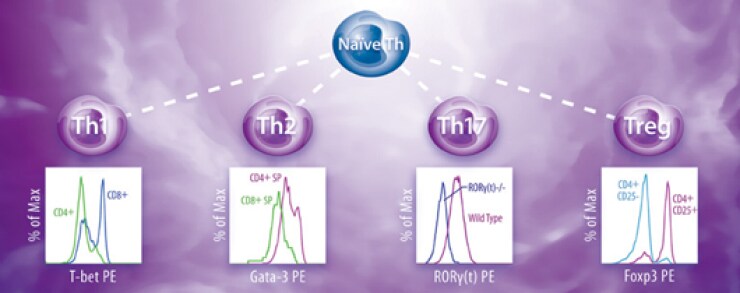Search Thermo Fisher Scientific
- Order Status
- Quick Order
-
Don't have an account ? Create Account
Search Thermo Fisher Scientific
Cellular differentiation requires the precise action of lineage-determining transcription factors. In the immune system, CD4+ T helper cells differentiate into at least four distinct effector lineages, T helper type 1 (Th1), Th2, T Regulatory (Treg) and Th17, with the fate of the cell, at least in part, determined by the transcription factors T-box expressed in T cells (T-bet), Gata-3, Foxp3 and retinoid-related orphan receptor gamma t (ROR gamma t), respectively. Importantly, these transcription factors are members of larger families that are required for numerous developmental transitions from early embryogenesis into adulthood. Mutations in members of these transcription factor families are associated with a number of human genetic diseases due to a failure in completing lineage-specification events when the factor is dysregulated. Mechanistically, there are both common and distinct functional activities that are utilized by T-box, GATA and ROR family members to globally alter the cellular gene expression profiles at specific cell fate decision checkpoints. Therefore, understanding the molecular events that contribute to the ability of T-bet, GATA-3 and ROR gamma t to define T helper cell lineages can provide valuable information relevant to the establishment of other developmental systems and, conversely, information from diverse developmental systems may provide unexpected insights into the molecular mechanisms utilized in T helper cell differentiation.
The differentiation of T cell lineages is known to occur from CD4+ T cell precursors. In the case of Th1, Th2 and Th17 cells this occurs in peripheral sites in response to locally produced cytokines. Differentiation of Tregs occurs either in the thymus (natural Tregs) or in the periphery (induced Tregs). The identification of direct targets of the transcription factors will be critical for a full understanding of the induction and function of each helper T cell population. The detection of “master-regulator” transcription factors necessary for appropriate T lineage gene expression serve as markers of definitive identification of each of these lineages.
For Research Use Only. Not for use in diagnostic procedures.
